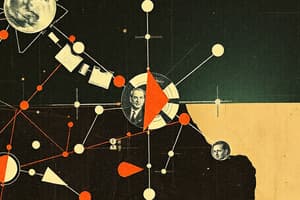Podcast
Questions and Answers
What is the atomic number of an element defined by?
What is the atomic number of an element defined by?
- Number of protons (correct)
- Number of neutrons
- Number of protons and electrons
- Number of neutrons and protons
Which subatomic particle has a positive charge and is located in the nucleus of an atom?
Which subatomic particle has a positive charge and is located in the nucleus of an atom?
- Neutron
- Electron
- Proton (correct)
- All of the above
What is the mass number of an atom defined by?
What is the mass number of an atom defined by?
- Number of protons and electrons
- Number of electrons
- Number of protons
- Number of protons and neutrons (correct)
How is the atomic number represented in the periodic table?
How is the atomic number represented in the periodic table?
Which subatomic particle essentially has no mass?
Which subatomic particle essentially has no mass?
What does the mass number of an element represent?
What does the mass number of an element represent?
How can one calculate the number of neutrons in an atom using atomic and mass numbers?
How can one calculate the number of neutrons in an atom using atomic and mass numbers?
Why is the atomic number considered a fundamental property of an element?
Why is the atomic number considered a fundamental property of an element?
What distinguishes mass number from atomic mass?
What distinguishes mass number from atomic mass?
What are isobars based on the text?
What are isobars based on the text?
What is the charge and location of a neutron in an atom?
What is the charge and location of a neutron in an atom?
How can one determine the atomic number of an atom?
How can one determine the atomic number of an atom?
What is the relationship between mass number and isotopes?
What is the relationship between mass number and isotopes?
What is the formula for calculating the mass number of an atom?
What is the formula for calculating the mass number of an atom?
Why must one know the number of neutrons to find the mass number of a specific atom?
Why must one know the number of neutrons to find the mass number of a specific atom?
Flashcards are hidden until you start studying
Study Notes
Atomic Number
- Defined by the number of protons present in the nucleus of an atom
- Represents the identity of an element
- Unique to each element
Subatomic Particles
- Protons: have a positive charge, located in the nucleus, and determine the atomic number
- Neutrons: have no charge, located in the nucleus, and contribute to the mass number
- Electrons: have a negative charge, located outside the nucleus, and have negligible mass
Mass Number
- Defined by the sum of protons and neutrons in an atom
- Represents the total number of nucleons in an atom
- Can vary for the same element, resulting in different isotopes
Atomic Number in the Periodic Table
- Represented by the symbol Z
- Placed at the top of each element's box in the periodic table
Calculating Neutrons
- Number of neutrons = Mass Number - Atomic Number
- Requires knowledge of both atomic and mass numbers
Importance of Atomic Number
- Considered a fundamental property of an element
- Determines the chemical properties of an element
Mass Number vs. Atomic Mass
- Mass number is an integer value, while atomic mass is a weighted average of the mass numbers of naturally occurring isotopes
Isobars
- Atoms of different elements with the same mass number
- Distinguished by their atomic numbers
Neutrons
- Have no charge
- Located in the nucleus
- Contribute to the mass number of an atom
Determining Atomic Number
- Can be determined by the number of protons in an atom
- Unique to each element
Mass Number and Isotopes
- Isotopes of an element have the same atomic number but different mass numbers
- Result from variations in the number of neutrons
Calculating Mass Number
- Mass Number = Number of Protons + Number of Neutrons
Importance of Neutrons
- Must know the number of neutrons to find the mass number of a specific atom
Studying That Suits You
Use AI to generate personalized quizzes and flashcards to suit your learning preferences.




